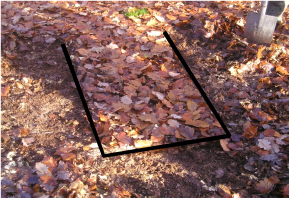





People involved in this research topic:
Key references in this research topic:
Our understanding of the world of insect is highly biased by the senses we use the most (vision, olfaction, sound), or which have potential immediate application (olfaction). This does not necessarily reflect their relative importance for insects. The role in insect life of wave propagation in solids, fluids (air, water) and granular materials (sand) is a largely neglected area which we find most interesting. It matters for prey and predator recognition, mate
What did we found so far?
Sand is a strange material, behaving sometimes like a fluid, sometimes like a solid.
Antlions make full use of this behaviour and are able to orient themselves while
buried in the sand. We chose this unique animal construction in the hope to be able
to define optimality in this context, an impossible task with spider webs, too complex
and with intermingled material/structure properties. We are studying how different
prey can escape the antlion pit, according to their gait, weight and other characteristics,
having thereby the two– the predator’s and the prey’s-
Insects communicating using vibratory signals face the problem of signal integrity. Indeed, as surface waves are of dispersive nature (i.e. frequency dependent wave velocities), signals change as function of the distance between emitter and receiver. An engineering approach using laser Doppler vibrometry, wavelets analysis of signals and nondimensionality of the wave propagation on plant stems revealed that insects can transmit signals of high integrity in using either signals of high frequencies or by choosing stems of large diameters. We also ventured into the realm of wave propagation at the water surface, using whirligig beetles, in the hope this problem would be more tractable.
Wind carries a lot of information, such as plant odours or kairomones, but its own temporal and spatial structure can also convey information. This is used by many insects equipped with filliform hairs which sense the smallest air movements. We are studying the air flow perception in the wood cricket attacked by wolf spiders. During an attack, wolf spiders displace air in front of them, to a distance of several centimetres (see Figure 2). This information can be used by crickets to escape. Of course, the environment is full of background noise, and its influence is so far unknown.
The theory of hide and seek search games are seldom used in studies of predator-
Our current understanding of the antlion pit is based on sand made of homogenous materials. Latest experiments show that things get more complex if you let the grain size vary, in particular since other physical principles dominate once the grain size is very small: the realm of powders. Furthermore, ants are the preferred prey and we know now why: the leg kinematics shows that they move very differently on sand or hard substrates and according to slope. The antlion trap is a bad combination of these two aspects for ants.
Using a piston mimicking the attack of a spider, we have recorded electrophysiologically
the response of crickets in the field. In order to study the air flow at the surface
of leaves in the litter, we mapped out, in 3D, leaf litter and studied its geometrical
features (Figure 4). A geometrically complex environment changes the spider-
Echolocation in wriggling beetles is an intriguing hypothesis which has found its
way in all textbooks, but we did not find any conclusive evidence for it so far.
By contrast, they most likely use the meniscus produced by objects are the air-
What next?
We would like to do much more with antlions, as they seem to defy some simple physics rules about the speed of surface wave propagation in sand and their ability to orient: where are the receptors and how can they fonction? Which concept of architectural optimality should we use over the lifetime of a pit, which includes events such of avalanches, restoring of the pit etc? What is about cleaning the pit containing heterogeneous materials? From the prey point of view, can we classify prey according to their leg kinematics and relate that to their rate of capture?
Surface wave propagation in semi-
We will pursue the field of research around the air flow sensing and the aerodynamics
of running arthropods for many years, because air sensitive hairs are everywhere
in the insect world, and the arachnid-
Hide and seek games are mathematically very different from pursuit-
Finally, we are always keen on adding well chosen examples to our growing collection
-


Thomas Steinmann
Antoine Humeau
Dupuy, F., Steinmann, T., Pierre, D., Christidès, J.-
Jonathan Voise, Michael Schindler, Jérôme Casas and Elie Raphaël (2011) Capillary-
Voise J. & Casas J. (2010). The management of fluid and wave resistances by whirligig
beetles, J. R. Soc. Interface, 7, 343-
Brice Bathellier, Thomas Steinmann, Friedrich G. Barth and Jérôme Casas (2011) Air
motion sensing hairs of arthropods detect high frequencies at near-
Casas, J., T. Steinmann & O. Dangles (2008)
The aerodynamics signature of running spiders.
PLoS One 3(5): e2116.
Casas, J., C. Magal & J. Sueur (2007) Dispersive and non-




location and many other aspects, such as avoidance of water droplets or abrasion through particles, for example. The aim of this research is to quantify the nature and role of wave propagation in the life of several insects, in order to have an understanding of the influence of the type of substrate and the kind of waves produced and perceived. The physics of the environment constrained the signals used by insects in a profound way we hardly grasp.
This quest explains the a priori disparate choices of topics ranging from the vibrations
through plants in herbivorous host-


Institut de Recherche sur la Biologie de l'Insecte
UMR 7261 Faculté des Sciences et Techniques
Avenue Monge, Parc Grandmont
37200 TOURS (France)

What is the question and the organisms studied?

